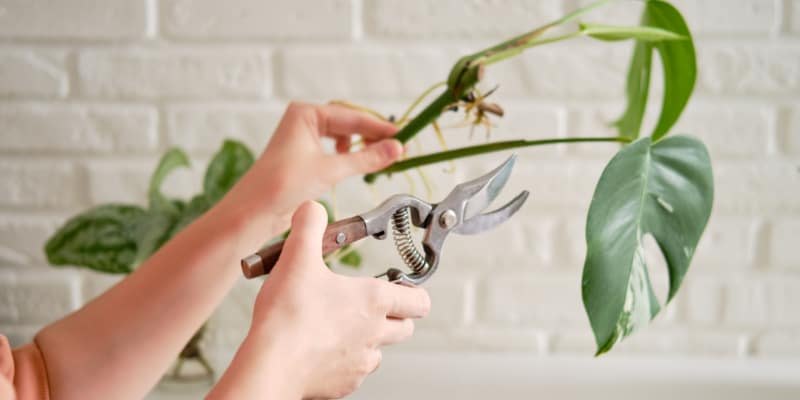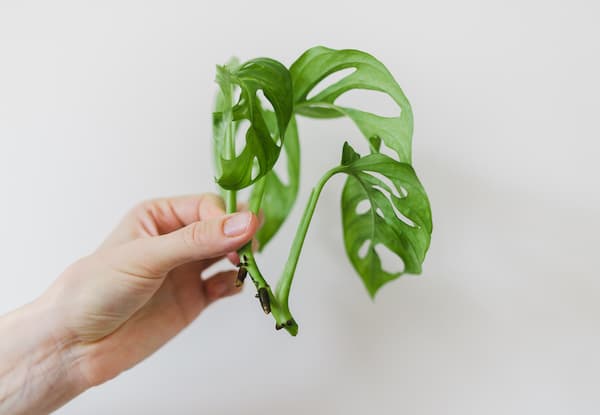
Discover the Joys of Swiss Cheese Plant Propagation with These Three Easy Methods
Our site is reader supported, this means we may earn a small commission from Amazon and other affiliates when you buy through links on our site.
You can choose from three ways of how to propagate a Swiss cheese plant – by stem cuttings, my personal favourite and probably the easiest, air layering or by seed which I don’t really recommend. The easiest method is by using bits of the stems that you cut off as they’re really easy to get to root. All three methods are straightforward but takes time for the new plants to grow.
I cover how to carry out all three processes in this guide, starting with my preferred fail-safe method, taking stem cuttings from an established plant.
Propagate by stem cuttings
Propagating a Swiss cheese plant by stem cuttings is a good way to use up any healthy stems that you cut off when you prune your plant. It’s also inexpensive, straightforward and has the best success rate, at least for me.
Here’s how to do it step by step.
First of all, Sterilise your cutting tools, for me I use secateurs.
Cut off a 10cm to 15cm piece of healthy stem from the plant. Make sure that the piece of the stem has a node on it – that’s a bump that roots come out of. You will notice them all along the stem, and they often become aerial roots. It also needs to have at least a couple of leaves and an aerial root.
Remove any leaves that are on the bottom half of the cutting.
Optional: pour some ground cinnamon (yes, from your kitchen spice collection) onto the big plant on the spot where you made your cut. This stops any infection from arising there.
Optional but highly recommended: apply a rooting hormone to the end of the cutting to help it produce its root. I always use rooting powder when propagating cutting of any plants.
Place the cutting in a small pot filled with potting mix with peat in it. Make sure the pot has enough drainage holes at the bottom so that the mix is moist but not wet. Soden wet soil if your worst enemy when growing cutting as it causes them to rot off.
Water the cutting and let the excess water drain out.
Place the pot in a warm place with bright but indirect light. Continue to care for it. In a few months, roots should begin to develop, so be patient.
Care for your new plant according to my guide on How to care for a Swiss cheese plant. Basiclly keep in bright but indirect sunlight and water as and when needed. For me, thats usually once a week, but I have a whole guide on watering Monstera here.
Propagate your Swiss cheese plant by air layering
This is a more low-risk method of propagating your plant as you don’t cut the new plant until it’s ready to be potted on its own. It’s an interesting type of propagation that can be very successful.
As always, Sterilise your cutting tool.
Look for a stem on the cheese plant that has a node.
Carefully make a short cut that’s only about one-third of the stem width. Do this just under the node.
Wrap some sphagnum moss around the cut and spray it with water.
Wrap plastic wrap around the moss and hold it in place with twist ties.
Make sure to keep the moss moist while the roots are developing in the node.
In a few months, when the roots have shown up, cut the stem beneath the node.
Place the young plant in a pot with potting soil and care for it according to the directions in How to care for a Swiss cheese plant.
Propagate from seed
Propagating your Swiss cheese plant from seed doesn’t really take much longer than by either of the other two methods to actually do but it takes much longer to get an established plant.
Buy your seeds. Monstera seeds don’t have a long shelf life, so buy them when you’re ready to plant them.
Soak the seeds in warm water for about 12 hours. They’ll expand, and this hugely increases the success rate of germination.
Put the seeds in individual pots or in a seed tray. Cover them lightly with seed-starting mix. I just use a standard seed compost.
Cover the pots or seed tray with plastic wrap or put the lid on your propagator if you have one. Place the pots/tray in a warm spot with bright but indirect light.
Frequently mist the growing medium to keep it moist but not wet. Be careful that it doesn’t become wet or waterlogged as the young seedling will rot off.
The seeds take a few weeks to germinate but can take longer, so be patient. Then remove the plastic wrap but keep the soil moist.
Transplant the seedlings after a few months.
Care for your plants according to the advice in my guide, How to care for a Swiss cheese plant but they basically need a warm position in indirect sunlight.
